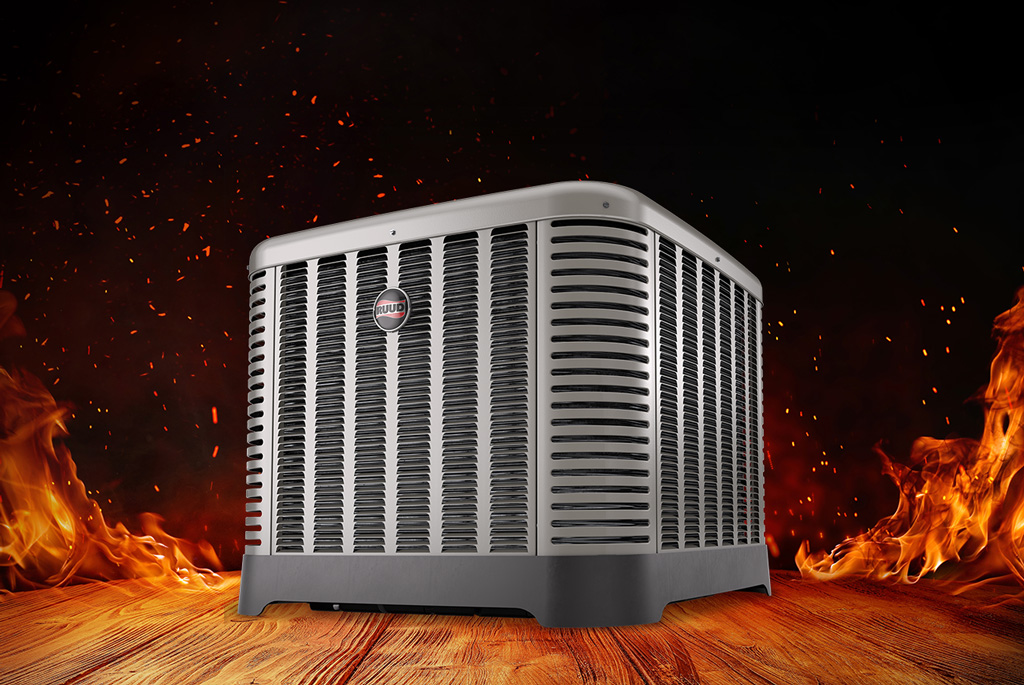My Heat Pump is on Fire!

By Brian Faulds, National Technical Trainer
With the push on heat pumps, electrification and carbon reductions, customers and contractors may be finding themselves in unfamiliar territory this winter. Many customers are installing heat pumps as they have been offered government rebates to offset the price, but don’t really understand how they work and what they do. Many technicians are still nervous about working on heat pumps and unclear about how they operate them and how to troubleshoot them as well. There are a few calls that you can expect regularly from customers who weren’t educated on how a heat pump works.
Heat Pump Frost: Indication or Problem?
A very common one is the frost building on the outdoor unit. As we all know, heat transfers from hot to cold, or from a higher temperature to a lower temperature. As such, when the outdoor air temperature is close to or below zero 0℃ (or 32℉), the refrigerant temperature must be lower than that so that heat energy can be absorbed into the refrigerant, and since that temperature is below freezing, the moisture in the air will freeze onto the outdoor coil creating a frost. To many customers (and technicians who are used to working on air conditioning), frost on the coil is a sign of a problem. With heat pumps, frost on the coil is simply an indication that it is cold outside.
How to Properly Understand and Operate Your Heat Pump
This leads us to the next call, which is also very common, and in the title of this article – “My heat pump is on fire!” This is a common misconception as the customer was often not made to understand some of the operational parameters of the unit. To the customer, they get out of bed in the middle of the night to get a sip of water, they happen to look out the window. The unit is running. They hear a click and a hiss, and the fan stops running but the unit sounds like it’s still running. Confused, they continue to watch and begin to see ‘smoke’ rising from the unit and panic thinking it’s on fire! What has happened, is that the heat pump has shifted into defrost. On most units, this consists of the reversing valve shifting into cooling positions and turning off the outdoor fan motor. As anyone who has worked on air conditioning knows, turning off the outdoor fan motor will cause that coil to heat up as there is no air movement to transfer the heat to. In this case, the frost on the unit evaporates quickly from the unit, causing the unit to steam. If we explain this to our customers and what to expect from these units, then we can save them that panicked thought!
Managing Customer Expectations and Concerns
Another common call you can expect is that the heat pump isn’t working correctly, because the air coming out of the vents doesn’t feel hot and isn’t blowing very hard. Again, this directly correlates to the customer’s misconception the heat pump is a replacement for their furnace. This misconception stems largely from excitement over large rebates and a lack of managing customer expectations during the sales process. If we take the average temperature rise across the heat exchanger on a high-efficiency furnace of approximately 50 ℉, we have air going in usually around 70-75 ℉, and coming out the supply at 120-125 ℉ (usually approx. 150 cfm per 10,000BTU). The customer is used to that temperature coming out of their vents if they have a high-efficiency furnace. In a mid-efficiency or standard-efficiency furnace, that temperature is usually even hotter than that. Now we put in a heat pump. Heat pump usually has a temperature rise of 15-30℉ over the coil (Temp rise = BTU/(1.08 x CFM)), so they now have 85-100℉ air blowing out of the vent. To our customer’s uncalibrated ‘hand-o-meter’ over the vent, the air doesn’t feel as warm as it used to. We have to be sure to be compassionate and understand our customers’ confusion about this, while at the same time assuring them that the system is in fact working properly (assuming of course we have confirmed that it is). This year is likely to be a time of flux for many of us in the industry, as this summer we had a lot of heat pumps going into homes that didn’t have them previously. We are likely to receive many calls where the customers’ concerns are simply due to the different operating dynamics of their system when compared to their previous heating system. Furthermore, whatever our frustrations are at these calls, we must be empathetic to the way the customer perceives these issues, as they may feel they have been misled or misinformed. Heat pumps will have a lot fewer on/off cycles during the day than their furnace did and run at a lower temperature. Having set back temperatures during the night as many customers have previously done to save energy can lead to discomfort in the daytime as the heat pump will typically either take a lot longer to make up the temperature difference or will have to bring on a less efficient auxiliary heat source to catch up in a reasonable time. A heat pump is a great, efficient way to heat your home, but as with any other change in technology, there are growing pains that come hand in hand with it and we must be sure to respect that the adoption of new technologies always takes time, and change is always a mentally uncomfortable state for people. No one likes to feel ignorant. Good luck out there, keep fighting the good fight, keeping people safe, warm and comfortable in their homes!
